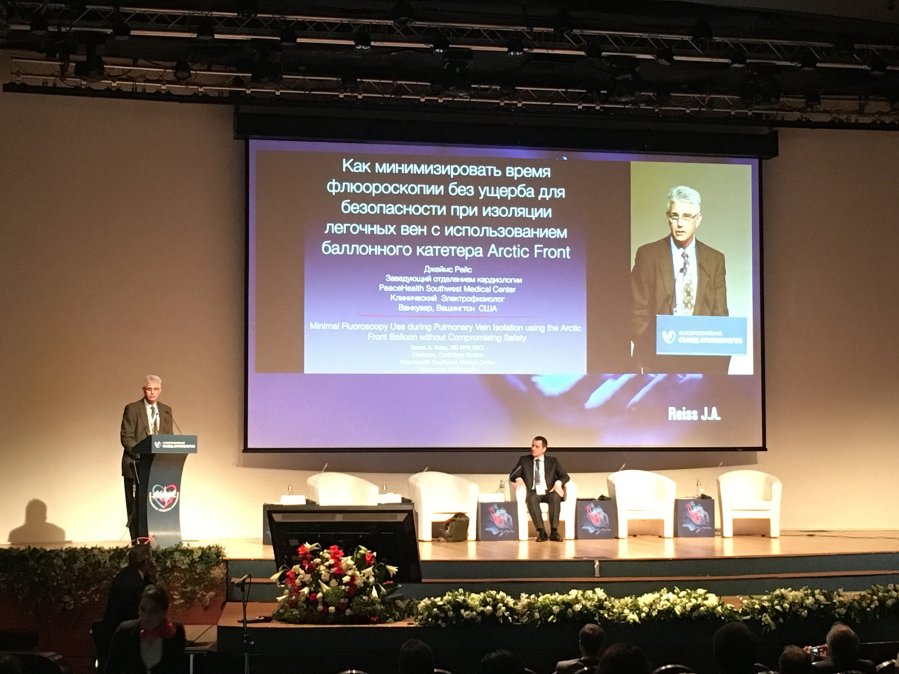When Dr. James Reiss performed his first cryoablation procedure to treat atrial fibrillation in 2011, his patient was exposed to X-ray radiation for 40 minutes.
Now, Reiss’ patients undergoing the procedure — last year he performed 100 of the procedures — are exposed to less than 30 seconds of radiation. The average exposure at medical centers across the country and around the world is 20 to 30 minutes.
“We made it a safe procedure,” Reiss said. “And there are very few people in the world doing that.”
Cardiologists and professional organizations around the globe are taking notice of the work Reiss is doing at PeaceHealth Southwest Medical Center. In the last six months, Reiss has traveled to Chicago, Russia, Kazakhstan and, most recently, Siberia to teach others his methods for dramatically reducing X-ray exposure during the procedure.
“There’s a lot of interest around the world in what we do,” he said.
High-tech treatment
Reiss is an electrophysiologist, a type of cardiologist who specializes in heart rhythm disorders and electrical activity of the heart.
When Reiss began performing cryoablation in 2011, the Food and Drug Administration had just approved the procedure. Cryoablation uses liquid nitrogen to block the triggers causing atrial fibrillation. It is considered an alternative for patients whose atrial fibrillation cannot be managed by medication.
Atrial fibrillation is an irregular and often rapid heart rate. During atrial fibrillation, the heart’s two upper chambers beat chaotically and irregularly, out of coordination with the lower two chambers of the heart, according to Mayo Clinic.
With cryoablation, Reiss inserts a catheter into a blood vessel in the groin and guides it to the heart. The end of the catheter has a balloon that inflates to 28 millimeters.
Reiss guides the catheter to each of the four veins in the left atrium of the heart where atrial fibrillation occurs. Once the catheter is in place at the mouth of the vein, the balloon is inflated. The balloon fills with liquid nitrogen — which is typically about minus 58 degrees Fahrenheit — and freezes the tissue for 150 seconds.
Freezing the tissue isolates the vein and prevents the electrical signals that would cause atrial fibrillation to reach the left atrium.
Most cardiologists performing cryoablation use X-ray throughout the entire process. That allows them to follow the wires through the heart but also allows patients’ bodies to absorb high amounts of X-ray radiation, Reiss said. Reiss, however, has adopted three tricks that reduce his reliance on X-ray.
First, he uses 3-D mapping of the heart, which allows him to watch in real-time what’s happening on a model of the patient’s heart. His second tool is intracardiac echocardiography, a type of ultrasound of the heart.
Finally — the trick most others haven’t adopted — Reiss watches the pressure in the balloon. The pressure changes when the balloon has inflated and touches the tissue, which tells Reiss he’s made good connection with the vein.
Those tricks have allowed Reiss to reduce his patient radiation exposure 95 percent in just the last three years, he said.
“It’s effective,” Reiss said of the procedure. “It’s now much safer than it ever was.”
Globe-trotter
As word started to get out about Reiss’ work, the invitations to speak at international events started coming in.
In May, Reiss went to Chicago to give a presentation at the Heart Rhythm Society’s international meeting. After that, he went to Moscow where he gave a presentation at the “All-Russia with Arrhythmia Conference” in June.
Reiss was back in Russia the following month, this time in St. Petersburg, to work side-by-side with physicians, demonstrating how to use minimal X-ray. In September, Reiss went to Astana, Kazakhstan, where he spoke about his work in Vancouver and performed a live procedure that was broadcast on TV. During that procedure, Reiss used 36 seconds of X-ray.
Last month, Reiss was in Siberia to speak at another international conference.
During his travels, Reiss said it’s become apparent that there’s great work happening in Clark County.
“We’re a small regional hospital, and yet, we’re doing work very few people in the world are doing,” Reiss said.
“(Patients) don’t have to go to Portland or Seattle or San Francisco to get really good care,” he added. “I don’t think sometimes people realize what a great hospital this is.”





